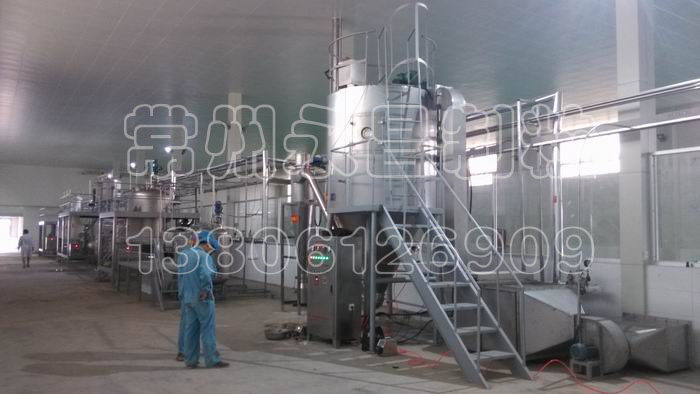Spray drying is a three-step drying process involving
both particle formation and drying. (1) The process begins with the atomization
of a liquid feed into a spray of fine droplets. (2) Then a heated gas stream
suspends the droplets, evaporating the liquid and leaving the solids in
essentially their original size and shape. (3) Finally, the dried powder is
separated from the gas stream and collected. Spent drying gas is either treated
and exhausted to the atmosphere or recirculated to the system. These three
steps are accomplished by three components: the atomizer, the disperser, and
the drying chamber.
The selection and operation of the atomizer is of
extreme importance in achieving an optimum operation and production of
top-quality powders. There are four main types of atomization:
o
Centrifugal atomization, the most common, uses a rotating wheel or disc to
break the liquid stream into droplets. The rotational speed determines the mean
particle size, while the particle size distribution about the mean remains
fairly constant in a system. Centrifugal atomizers are available in a large
variety of sizes, from laboratory scale to very large commercial units.
o
Hydraulic pressure-nozzle atomization forces pressurized fluid through an
orifice. Multiple nozzles are used to increase capacity. The particle size
depends on the pressure drop across the orifice, so that the orifice size
determines the capacity of the system. This type of atomization is simpler than
centrifugal, but cannot be controlled as well. It is not suitable for abrasive
materials, or materials that tend to plug the orifices.
o
Two-fluid pneumatic atomization uses nozzles, as well, but introduces a
second fluid, usually compressed air, into the liquid stream to atomize it.
This type of atomization has the advantage of relatively low pressures and
velocities and a shorter required drying path. It is most often used in
small-scale equipment, laboratory or pilot size.
o
Sonic atomization, not yet widely used, passes a liquid over a surface
vibrated at ultrasonic frequencies. It can produce very fine droplets at low
flow rates. Current limitations are capacity and the range of different product
that can be atomized.
After atomization, a disperser brings the heated gas
into contact with the droplets. The disperser must accomplish three things: mix
the gas with the droplets, begin the drying process, and determine the flow
paths through the drying chamber. The drying gas may be heated directly by
combustion of natural gas, propane, or fuel oil, or indirectly using shell-and-tube
or finned heat exchangers. Electric heaters may be used in small dryers.
Industrial radial fans move the heated gas through the system.
The drying chamber must be sized to allow adequate
contact time for evaporation of all of the liquid to produce a dry powder
product. Factors that impact the drying time include the temperature difference
between the droplets and the drying gas, and their flow rates. The exact shape
of the chamber depends on the drying characteristics and product specifications,
but most are cylindrical with a cone-shaped lower section to facilitate
collection of the product.
Finally, proper configuration of the atomizer,
disperser, and drying chamber is essential for complete drying and to avoid the
deposit of wet material on the interior surfaces of the dryer. Designs may use
co-current, counter-current, or mixed flow patterns.
The powder is separated from the drying gas at the
bottom of the chamber. Most often, the gas exits through an outlet duct in the
center of the cone. Heavier or coarser particles will be separated at this
point, dropping into the cone to be collected through an air lock. Then either
cyclones or fabric filters (or both) remove the remaining powder from the exit
gas. In systems producing a very fine powder, most of the collection takes
place at this point.
